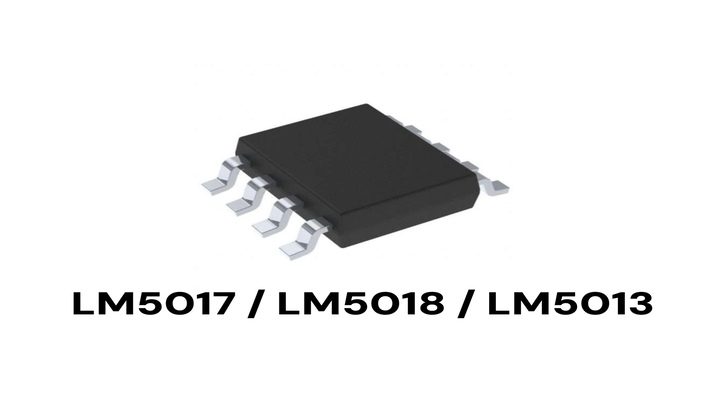
In industrial control, automotive electronics, and distributed power systems, high-voltage buck converters play a central role in modern power architecture. From motor drives to communication base stations, system stability largely depends on the power converter’s efficiency, thermal management, and reliability. Under varying load and environmental conditions, achieving the right balance between power density, size, and temperature rise has become a key criterion for evaluating power design quality.
Texas Instruments’ LM501x series provides a proven lineup of devices that cover multiple power levels. This guide focuses on three representative models — LM5017MRX/NOPB, LM5018MR/NOPB, and LM5013QDDARQ1 — and compares their parameters and applications to support efficient and reliable power selection.
Parameter Comparison
LM5018MR/NOPB | LM5017MRX/NOPB | LM5013QDDARQ1 | |
Input Voltage Range | 7.5 V – 100 V | 7.5 V – 100 V | 6 V – 100 V |
Maximum Output Current | 300 mA | 600 mA | 3.5 A |
Switching Frequency | Adjustable up to 1 MHz | Adjustable up to 1 MHz | Up to 1 MHz |
Topology | Synchronous Buck | Synchronous Buck | Non-synchronous Buck |
Quiescent Current (IQ) | Low | Low | Ultra-low (1.2 µA) |
Package Type | 8-SO PowerPAD | 8-SO PowerPAD | 8-HSOP PowerPAD |
AEC-Q100 Qualification | No | No | Yes |
Feature Focus | High-efficiency light load | General-purpose mid-power | Automotive-grade high current |
Application Insights
LM5017MRX/NOPB
The LM5017 achieves an excellent balance between power density and efficiency at the 100V input level. It is suitable for industrial systems that face spatial and thermal constraints but demand stable output performance.
Common applications include industrial control, power modules, and LED drivers, where it provides flexible transient response and solid reliability.
LM5018MR/NOPB
As the light-load version of the LM5017, the LM5018 emphasizes efficiency and compact design. It can deliver high conversion efficiency without the need for additional heat sinking in low- to mid-power systems.
This makes it ideal for measurement terminals, battery-powered controllers, and compact IoT modules.
LM5013QDDARQ1
The LM5013QDDARQ1 offers up to 3.5A output current and features ultra-low quiescent current, making it well-suited for 48V bus systems that step down to lower rails.
With AEC-Q100 qualification, programmable current limiting, and strong reliability, it is widely used in MHEV/EV, ADAS, and vehicle control systems.
Design Considerations
Power Segmentation
The LM5013 supports up to 3.5A output, targeting high-current systems. The LM5017 and LM5018 cover the low- to mid-power range, enabling modular and unified design across platforms.
Architecture Trade-offs
Synchronous design (LM5017/LM5018) improves light-load efficiency and reduces external component count.
Non-synchronous design (LM5013) provides better robustness under heavy loads and thermal stress.
Thermal Design and Packaging
All three devices adopt PowerPAD™ packaging, featuring optimized thermal paths for effective heat dissipation.
Each device integrates overcurrent protection, thermal shutdown, and UVLO, ensuring compliance with both industrial and automotive safety requirements.
System Protection
In addition to built-in overcurrent, thermal, and UVLO protection, the LM5013 includes soft-start, programmable current limit, and overvoltage protection, providing enhanced system safety for automotive environments.
Layout Compatibility
The LM5017 and LM5018 share a pin-compatible layout, allowing easy design reuse or scaling between power levels without changing the PCB.
Substitution & Migration Recommendations
LM5017 ↔ LM5018
Both devices share identical packaging and control architecture, effectively serving as the same platform with different power levels.
For light-load or thermally constrained designs, the LM5018 is a more efficient alternative to the LM5017.
LM5017 ↔ LM5013
When upgrading from standard industrial designs to automotive or high-current environments, systems can migrate to LM5013QDDARQ1.
Minor adjustments to the driver circuitry and thermal layout are recommended to accommodate the non-synchronous architecture.
LM5018 ↔ LM5013
The LM5018 targets light-load IoT modules, while the LM5013 supports 48V main bus systems and high-power equipment — forming a natural extension from edge nodes to main power rails.
The LM5018, LM5017, and LM5013 are representative models within TI’s high-voltage buck converter family, each emphasizing distinct application priorities:
LM5018 – Light-load efficiency and compact design
LM5017 – Standard mid-power performance platform
LM5013 – High-current, automotive-grade reliability
With consistent packaging and well-defined performance tiers, the LM501x family enables flexible, efficient system scaling.
Across industrial control, automotive systems, and distributed power networks, these devices deliver an ideal balance of efficiency, thermal performance, and long-term reliability.
Key Takeaways
LM5018 – Light and Lean
LM5017 – Balanced Performer
LM5013 – Heavy and Hardy
WIN SOURCE provides in-stock availability and comprehensive technical support for all three models, helping customers accelerate high-performance power design and maintain long-term supply stability. Visit WIN SOURCE for real-time inventory and lead-time updates.
©2025 Win Source Electronics. All rights reserved. This content is protected by copyright and may not be reproduced, distributed, transmitted, cached or otherwise used, except with the prior written permission of Win Source Electronics.

COMMENTS